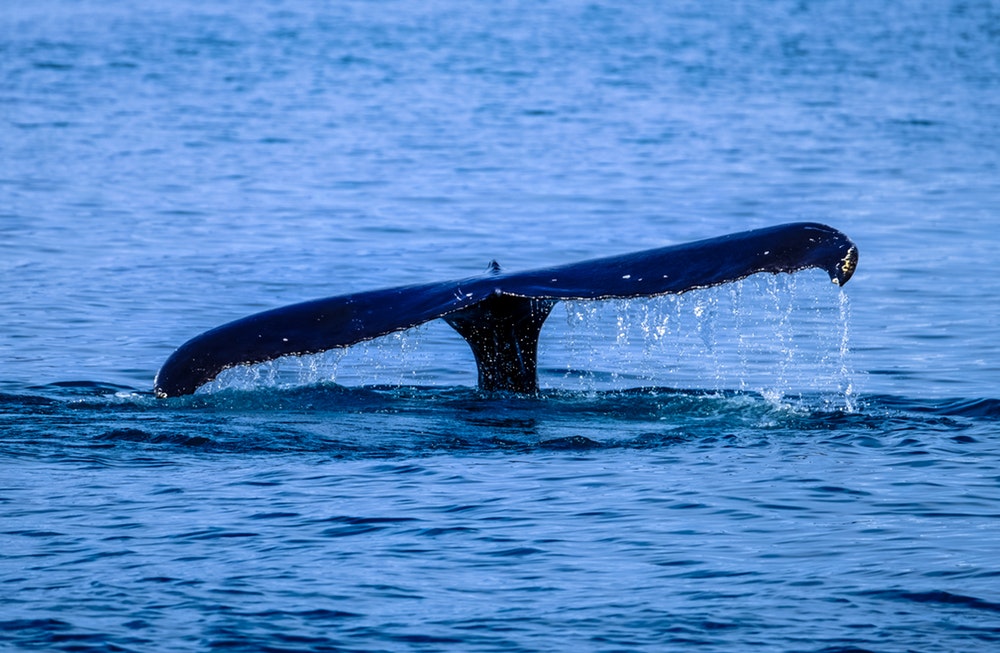
8 things you need to know about hunting whales
For the Inuit people of North America, hunting whales is serious business. They plan for whale hunting season all winter long and when spring comes, they station scouts to watch for signs that the ice is breaking up and the hunt can begin.
Scouting, hunting, and harvesting a whale is a major undertaking that requires the support of the entire community.
But when they succeed, a single catch can feed the entire village for a year.
When Barbara Weaver Smith first heard about the whale hunters, she was inspired by their strength, courage, and tenacity. As she continued to learn more about their process, she saw their story’s potential as a powerful metaphor and model for sales.
Smith’s company, The Whale Hunters, helps small and mid-sized organizations go after sales deals with much larger companies. Using whale hunting as a “metaphor, model, and map,” Smith’s clients learn to land deals that are between 10 and 20 times their previous average deal size.
We are thrilled to have Smith and The Whale Hunters joining the Membrain team as a partner. Smith’s team is currently working on integrating her process and methodology into the Membrain platform to offer as a package to their clients as well as Membrain’s via our sales enablement marketplace.
We caught up with Smith recently to talk about whale hunting. Here’s what we learned.
1. Whale Hunting is a Metaphor, a Model, and a Map
“It’s a metaphor because it represents the three major stages and nine phases of the actual Inuit hunt,” says Smith, describing the strategic process her company teaches to clients. “It’s a model because it works for all B2B companies in all industries. And it’s a map, because each company will develop its own versions of the phases depending on what they sell and to whom.”
2. It’s Not About the Biggest Whale, It’s About the Right Whale
“There’s a species of whale that is known as the right whale,” says Smith. “Most people don’t know the reason they’re called that. In the early days of European whaling expeditions, European whaling boats didn’t have the skills, experience, team size, and equipment to hunt the really large whales. But the right whale is slow, it swims close to the shore, and when it’s dead it floats instead of sinking. These factors make it possible for a small European whaling team to hunt and harvest the whale unassisted, and thus they named it the right whale.”
Smith’s sales process starts with a stage called the “scouting” stage, and one of its elements is selecting the right whales for the sales team to go after. The more experienced and larger your team and resources, the larger and more difficult whales you can go after.
“We talk about a right whale 10-20 times the current average deal size–not necessarily the biggest whale in the ocean, but one you can realistically hunt, land, and take care of after you’ve made the sale.”
3. “Sewing the Mouth Shut” is Critical
Hunting a whale is not for the faint of heart, especially when you’re small and operating with simple, low-tech tools. For instance, harpooning a whale doesn’t immediately kill it. At first, it just makes it mad. The Inuit have many techniques for slowing the whale down and eventually bringing it under control, but one of the most important and perilous moments for the whale hunting team occurs right after the whale finally dies.
For the Inuit, the “right whale” isn’t usually a right whale. They generally go after the larger species of whales, and the monsters they hunt don’t float when they die. There’s a critical moment in every hunt, when the hunters must sew the mouth of the whale shut. If they fail to do it quickly enough or thoroughly enough, water will flood the whale’s carcass and it will sink to the bottom of the ocean. This wastes all of the precious resources and time that the team expended on the hunt, and puts them at risk of sinking with it.
“If you’re a small company dealing with a large client,” says Smith, “there’s a dangerous time in the deal when the client has said yes, but you haven’t been paid for your first invoice. They may change their mind, they may not ramp up as fast as you thought they would. This is the worst time to lose a deal, so we teach our clients how to ‘sew the mouth shut’ and keep the deal afloat long enough to harvest the rewards.”
4. Whales Don’t Behave Like Fish
“Lots of companies, even big tech companies, didn’t start out selling to the biggest companies in the world,” says Smith. “They sell to mid-sized companies with small teams, and that’s where they get their early selling experience. In this kind of sale, you can pick up the phone and talk to an owner or a vice president. They may be bigger than you are, but they’re not qualitatively different.”
All that changes when a company starts hunting whales.
“A multi-national corporation is different in every possible way from the small and mid-sized companies who hunt them,” says Smith. “And that leads to a lot of mistakes when first going after those big deals. You don’t know who you should talk to, how to get in the door, how to deal with procurement, or how to become a preferred vendor. In many cases, you don’t know that you need to be a preferred vendor or even what terminology they’re using, and you don’t know that they’re terrified to do business with someone small like you. Most of all, you don’t know what you don’t know.”
Part of Smith’s job is teaching small and mid-sized companies how these behemoths operate and how they buy, so they can avoid the most common mistakes, and land their first big deal.
5. Whale Hunting is Complex, but the Right Tools Make it Simpler
“Selling to large accounts is complicated,” says Smith. “There’s a lot of information you’re gathering along the way. Salespeople need to have this information at their fingertips, and they shouldn’t be spending a lot of time doing the research themselves. It’s not a good use of their time. There needs to be a good research process in place, and there needs to be a place where all this information is housed and can be synthesized and made useful to the sales team.”
That’s why Smith partnered with Membrain.
“The #1 thing I like about Membrain is that it’s made for that. It’s made to put all kinds of information painlessly and instantly at the fingertips of the salesperson. There are places in Membrain where I can house all of the teaching and learning as part of the playbook and sales enablement toolkit. It’s all built in and all I have to do is populate it with knowledge and information. I’ve been looking for this for years.”
Additionally, she says, the platform is priced right for her clientele. There are some other platforms that could theoretically do what Membrain does, but, “they’re not priced for anybody that I’m doing business with and, frankly, they’re clunky and they’re not as good or as clever as Membrain.”
6. Membrain’s Content Hub Makes it the Perfect, Complete Whale Hunting Toolkit
“I met George, Membrain's founder, a few years ago,” says Smith, “but I didn’t realize how badly I needed Membrain at that time. I came back around when they announced the Content Hub. It was the final piece I needed. With the Content Hub, Membrain not only enables me to execute effectively on my sales process, it also provides the platform for handling both internal training and learning content, and managing client-facing content.”
7. Whale Hunting Isn’t Just a Sales Approach
Smith clarifies that although people think of Whale Hunting as being a sales approach, it’s actually a complete business development system.
“It’s conceptual and it’s really about business development,” says Smith. “It’s not just a sales training system. The sales team may need sales training, but the whole system has to make its way into the minds and behaviors of the entire company, from the sales team to marketing, operations, management, and customer success. And not just into their everyday tactics, but their core point of view about big accounts. It’s team sales, and by definition the team needs to collect and present and share a lot of information.”
This requires a major sales enablement undertaking, for which, once again, Smith sees Membrain as the perfect platform.
“Membrain allows for sharing information, and for instruction, guidance, and coaching to be built in,” says Smith. “Coaches and managers can see what’s going on and intervene promptly. Potentially hundreds of people at a multi-national account may touch your company, and there may be multiple projects and sales over time. People come and go on both sides, so there’s a constant churn of data. You have to have consistent ways to tell people at every step of the process what’s happening and what needs to happen. Membrain allows us to do that.”
8. The Whale Hunters Partnership with Membrain is a Win-Win-Win
“I’m building the Whale Hunters process into Membrain,” says Smith. “It’s the perfect fit, and I’m excited to see it on the Membrain website, in the sales enablement marketplace. I have the greatest respect for the Membrain team, and I can’t wait to roll this out to my customers.”
The partnership, she adds, “is a win for me and I intend to make it a win for Membrain, and it will definitely be a win for our clients. It’s very exciting all around.”
The feeling is mutual. We’re thrilled to have Smith on board as a partner, and we’re looking forward to offering her system in our sales enablement marketplace. You can read her book here or contact us to request a demo of Membrain
 About Barbara Weaver Smith
About Barbara Weaver Smith
Founder and CEO of The Whale Hunters, Barbara Weaver Smith helps B2B companies grow fast by making bigger sales to bigger customers. For 20 years she has led growth-oriented companies to implement a complete business development system for selling successfully into large account, enterprise markets, including learning how to go global with global customers. Barbara’s clients say, “If you’re selling to large companies and you have a complex sale, multiple points of contact, and you have to develop relationships with these accounts, this is a no brainer.” Barbara wrote Whale Hunting with Global Accounts and co-authored Whale Hunting: How to Land Big Sales and Transform Your Company.

By George Brontén
George is the founder & CEO of Membrain, the Sales Enablement CRM that makes it easy to execute your sales strategy. A life-long entrepreneur with 20 years of experience in the software space and a passion for sales and marketing. With the life motto "Don't settle for mainstream", he is always looking for new ways to achieve improved business results using innovative software, skills, and processes. George is also the author of the book Stop Killing Deals and the host of the Stop Killing Deals webinar and podcast series.
Find out more about George Brontén on LinkedIn







